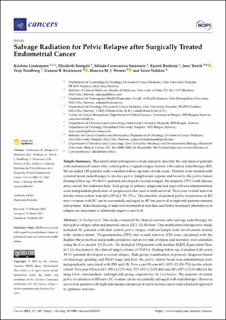| dc.contributor.author | Lindemann, Kristina Yvonne Kathe | |
| dc.contributor.author | Smogeli, Aud Elisabeth Farstad | |
| dc.contributor.author | Småstuen, Milada Cvancarova | |
| dc.contributor.author | Bruheim, Kjersti | |
| dc.contributor.author | Trovik, Jone | |
| dc.contributor.author | Nordberg, Terje | |
| dc.contributor.author | Kristensen, Gunnar S Balle | |
| dc.contributor.author | Werner, Henrica Maria Johanna | |
| dc.contributor.author | Nakken, Ester | |
| dc.date.accessioned | 2022-02-07T12:47:20Z | |
| dc.date.available | 2022-02-07T12:47:20Z | |
| dc.date.created | 2022-01-10T21:17:21Z | |
| dc.date.issued | 2021 | |
| dc.identifier.issn | 2072-6694 | |
| dc.identifier.uri | https://hdl.handle.net/11250/2977497 | |
| dc.description.abstract | (1) Background: This study evaluated the clinical outcome after salvage radiotherapy for first pelvic relapse after endometrial cancer (EC). (2) Methods: This multicenter retrospective study included EC patients with first central pelvic relapse without lymph node involvement treated with curative intent. Progression-free (PFS) and overall survival (OS) were calculated with the Kaplan–Meier method and possible predictive factors for risk of relapse and mortality were identified using the Cox model. (3) Results: We included 139 patients with median EQD2 (Equivalent Dose in 2 Gy fractions) to the clinical target volume of 70.0 Gy. During follow up of median 6.66 years, 39.6% patients developed a second relapse. Risk group classification at primary diagnosis based on histology, grading and FIGO stage and how the pelvic tumor boost was administered were independently associated with PFS and OS. Five-year OS was 68% (95% CI (59–75)) for the whole cohort. Five-year OS was 88% (95% CI (75–94)), 72% (95% CI (55–84)) and 38% (95% CI (15–60)) for the stage I low-, intermediate- and high-risk group, respectively. (4) Conclusions: The majority of central pelvic recurrences in RT-naive EC women can be successfully salvaged with radiotherapy. However, survival in patients with high-risk disease remains poor and warrants a more individualized approach to optimize outcome. | en_US |
| dc.language.iso | eng | en_US |
| dc.publisher | MDPI | en_US |
| dc.rights | Navngivelse 4.0 Internasjonal | * |
| dc.rights.uri | http://creativecommons.org/licenses/by/4.0/deed.no | * |
| dc.title | Salvage Radiation for Pelvic Relapse after Surgically Treated Endometrial Cancer | en_US |
| dc.type | Journal article | en_US |
| dc.type | Peer reviewed | en_US |
| dc.description.version | publishedVersion | en_US |
| dc.rights.holder | Copyright 2021 by the authors. | en_US |
| dc.source.articlenumber | 1367 | en_US |
| cristin.ispublished | true | |
| cristin.fulltext | original | |
| cristin.qualitycode | 1 | |
| dc.identifier.doi | 10.3390/cancers13061367 | |
| dc.identifier.cristin | 1977916 | |
| dc.source.journal | Cancers | en_US |
| dc.identifier.citation | Cancers. 2021, 13 (6), 1367. | en_US |
| dc.source.volume | 13 | en_US |
| dc.source.issue | 6 | en_US |

